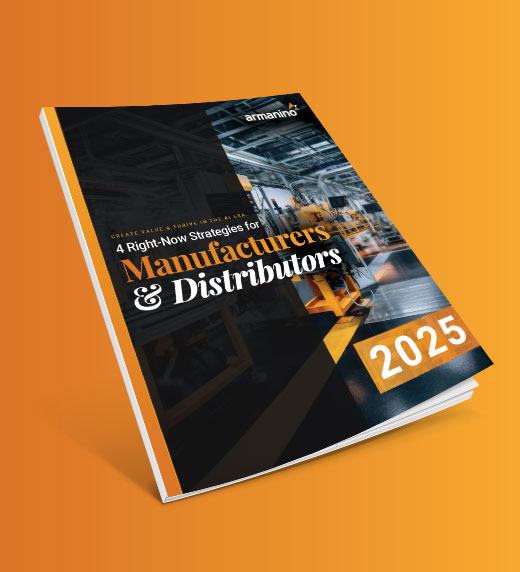
TLDR: Despite common misconceptions, M&D is evolving rapidly. From AI and automation to workforce strategy and supply chain resilience, this piece breaks down six persistent myths and reveals the real trends shaping the future of M&D in 2025 and beyond.
As a manufacturing and distribution (M&D) leader, you know it can be difficult to separate rumor from reality. Whether it’s outdated assumptions about your industry, skepticism around artificial intelligence (AI) and automation or the belief that new hires alone will solve ongoing talent shortages and evolving workforce challenges, you’ve heard it all.
These myths don’t just cloud perception. They make your real-life challenges even harder to identify and overcome. From workforce shortages and supply chain instability to pricing pressure and rapid technological change, you’re navigating complex issues at a relentless pace, all while trying to keep operations running smoothly.
To lead effectively, you need to separate fiction from reality. Here’s a look at some pervasive industry myths and the actual trends behind them. Understanding what’s happening, and what to do about it, will help you lead with confidence, avoid costly missteps and stay resilient in 2025 and beyond.
Reality: M&D is rapidly modernizing. You need to evolve, too.
While the perception that M&D is stuck in the past still lingers, the reality is far more dynamic. M&D is by no means stagnant. Rather, the industry is growing at a rapid rate. Research from the U.S. Census Bureau estimates that the combined value of manufacturers’ shipments and distributive trade sales reached $1.92 trillion in March 2025, a 4.5% increase year-over-year.
This growth is increasingly fueled by advanced technologies like AI, robotics and additive manufacturing, which are redefining efficiency, product quality and agility across the sector. Additive manufacturing, for example, is changing how companies think about what can be produced quickly and cost-effectively. And with the AI-driven rise of Industry 5.0, manufacturers are blending human creativity with intelligent systems to reach new levels of innovation.
That said, the perception of manufacturing lagging behind often stems from the reality that many mid-market manufacturers still rely on manual processes and legacy systems, even as the broader industry moves forward. The pace of change is accelerating, and those who don’t modernize risk being left behind. Having a modern technology stack supporting operations has become a baseline requirement, and many companies are finding core competitive advantages by harnessing their operational data for insights.
Above all, agility is critical. Companies that can quickly adjust production lines, shift inventory strategies or respond to policy changes have a competitive advantage. For example, say a manufacturer detects a sudden spike in demand through real-time order data. With the right systems in place, they can quickly reconfigure production schedules and reroute inventory, avoiding stockout and capturing revenue their competitors might miss.
The bottom line? You don’t need to overhaul everything overnight, but you do need to start.
Reality: Replacing retiring workers isn’t enough. You need to rethink roles, capabilities, workflows and talent pipelines.
Succession planning isn’t optional. It’s urgent.
With 26% of the manufacturing workforce older than age 55 in 2024 according to the US Bureau of Labor Statistics, the clock is ticking on a huge wave of retirements expected over the next decade.
Many organizations are still trying to recover from the talent shortage that followed the COVID-19 pandemic when millions of workers left the industry. Now, the looming retirement of the Baby Boomer generation, often called the silver tsunami, is set to reshape the M&D workforce entirely. But what exactly does that mean for your company’s next steps?
Let’s say Bob, your CNC machinist who’s been with you for 35 years, is retiring next spring. No one else on your team can do anything remotely close to what Bob does. You can’t just hire someone and expect them to replace decades of institutional and technical knowledge on day one.
So, what do you do?
You rethink Bob’s job. What parts of it could be automated? Could you cross-train others to take on pieces of his role? How could you rethink your workflows to avoid getting stuck in this same situation again with another key employee who might walk out the door in a year or two?
Contending with the workforce shortage isn’t just about filling seats. It’s about building a resilient team and workflows that can grow with your business.
Reality: Reshoring isn’t a silver bullet. The real keys to resilience? Agility, visibility and strong third-party partnerships.
Your supply chain may no longer be a competitive advantage in today’s world. With changing tariff policies, growing supplier exposure to geopolitical, environmental and resource risks, and the potential for bottlenecks at major ports, your entire production line can grind to a halt. Reshoring or nearshoring might seem like an attractive response to global disruptions, especially with the lure of potential tax benefits, but the reality is far more complicated.
Many companies rely on specialty materials and components sourced from multiple countries, making a fully domestic supply chain unrealistic. For example, a consumer goods manufacturer might assemble products in the U.S. but still rely on plastic components from China and electronic sensors from South Korea.
Even if your factory is local, your supply chain probably isn’t. To fully understand the potential impact of shifting production locations, it’s essential to map the total cost of goods, including inputs from second-tier (or even deeper) suppliers.
Many organizations are already moving operations closer to where the final product is sold to reduce reliance on international suppliers, a move driven by supply chain disruptions that began during the COVID-19 pandemic. The current policy environment, including tariffs, trade restrictions and geopolitical tensions, is accelerating that change.
Visibility remains a challenge, especially when it comes to planning. Supply chain blind spots cause chaos, leading to missed deadlines and costly delays. Without clear insight into where materials are and when they’ll arrive, it’s nearly impossible to schedule production or set accurate delivery expectations.
Even with modern tools, many manufacturers still struggle to get accurate demand signals and track inventory across every stage of the supply process. If materials are in transit to your onshore facility, knowing their arrival time is critical for keeping operations on track. While technologies like RFID and IoT sensors are emerging, they’re not yet cost-effective or widely adopted. In the meantime, your organization must depend on strong supplier relationships, proactive communication and smart contingency planning.
Reality: Find opportunities to integrate AI across your organization to assist human workers, not replace them.
The fear that artificial intelligence (AI) will eliminate jobs is pervasive across many industries, but in manufacturing and distribution, the opposite is often true. M&D companies aren’t using AI to cut headcount. They’re using it to fill labor gaps, simplify repetitive tasks and help teams move faster and smarter.
For companies ready to go beyond the basics, AI can be a competitive advantage. Some M&D leaders are building custom AI models, capturing insights and efficiencies that off-the-shelf tools can’t deliver. For instance, a manufacturer might use AI to automatically generate quotes for custom-made parts by analyzing specifications and materials, saving time and improving accuracy in the sales process.
But you don’t need the flashiest tech to see success with AI. Consider using AI to improve processes in small, meaningful ways. Many manufacturers are experimenting with tools like ChatGPT or Copilot in sales, customer service, quoting and reporting. These aren’t sweeping, scary transformations. They’re practical, everyday tools that lighten people’s loads and make work easier.
And that’s the point. AI isn’t about replacing people. It’s about giving people the tools to work smarter. When used well, it can help get new hires up to speed faster, support more accurate reporting and take redundant tasks off your team’s plate, so everyone can focus on the work that moves the business forward.
Find smart, simple opportunities to integrate AI across your organization and make it work for you.
Reality: Your pricing strategy needs to be flexible and responsive to survive.
Treating pricing as a one-time decision, or something you revisit once a year, is a fast track to lost margin and missed opportunities. And with new players undercutting prices, defending your market share without sacrificing quality is more important than ever. Static pricing models, especially those built on spreadsheets or legacy systems, can’t keep up.
Some organizations are holding off on price changes, hoping the current policy environment — shaped by tariffs, trade policy shifts and regulatory changes — and broader market volatility will stabilize. But waiting it out is a risk. The longer you delay, the more margin you could be missing. And when pricing decisions rely on fast, data-driven insights that are difficult to access or interpret, that delay becomes even more drawn out.
Taking a dynamic, strategic approach to pricing can help you respond faster to market changes, improve profitability and strengthen customer relationships. This means more than just reacting to cost changes. It means building a model that can flex with your business, one that accounts for customer behavior, product mix, promotions and margin goals. It means aligning pricing with sales, finance and supply chain functions, not treating it as a siloed activity. And it means using data to spot inconsistencies, protect your margins and make informed decisions.
Reality: Back-office automation is the next frontier. And it’s where many manufacturers are already falling behind.
If your organization has invested heavily in shop floor automation, you might think you’ve done all you can to simplify and automate processes. But that’s only a piece of the puzzle.
While many manufacturers have become adept at tracking every metric on the shop floor, the back office is often stuck in the past. Processes like quoting, ordering, billing and reporting are still manual and inefficient.
Manufacturers are great at proving ROI on the shop floor because everything is measurable. But when it comes to the back office, the benefits of automation feel less tangible, so they get overlooked. The truth is that old tech results in waste (just like on a shop floor). Strategic upgrades to your financial systems can prevent costly breakdowns and boost efficiency.
This isn’t just a technical problem. It’s a mindset shift. As a manufacturing leader, you are likely used to thinking in terms of throughput and efficiency. Back-office automation means applying those same proven manufacturing best practices to all areas of the business, not just the shop floor.
Feeling overwhelmed by supply chain volatility, pricing pressure and the looming retirement cliff? The myth is that you can wait it all out. The reality? Forward-thinking M&D leaders are acting now. Find out how our Manufacturing and Distribution experts can help you build a smarter, more resilient operation — one equipped to seize opportunity, outpace disruption and thrive in any market.
If you have any questions or just want to reach out to one of our experts, use the form and we'll get back to you promptly.


